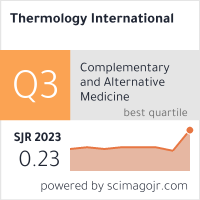American Academy of Thermology
Deutsche Gesellschaft für Thermographie & Regulationsmedizin
European Association of Thermology
Find volumes prior to 2012 in Archive
About the Evolution of the Thermographic Profile In Breast Cancer - A Case Report
Camila Planzo Sampaio, Carla Barreto Silva de Cerqueira, Juliana Borges de Lima Dantas, Mбrcia Maria Peixoto Leite, Alena Ribeiro Alves Peixoto Medrado
SUMMARY
INTRODUCTION: Patients suffering from lobular breast cancer bear a high risk of a metastasising disease. Since this type of neoplasia often presents with an asymptomatic and therefore insidious growth, establishing the diagnosis through imaging may be difficult.
STUDYAIM: To report the clinical course of a patient who presented with a lobular breast carcinoma and to illustrate the contribution of infrared thermography in monitoring this lesion.
METHODS: P.L.S, a female patient, 57 years old, was diagnosed with invasive lobular carcinoma in the lower right breast quadrant. A neoadjuvant chemotherapy was initiated to increase the chances of success of radical surgical therapy followed by radiation therapy. Before, during and after the completion of chemotherapy, infrared thermal images were taken of the patient's breasts in a private clinic by a physiotherapist who had been trained to record and evaluate infrared thermal images.
RESULTS: During chemotherapy, the temperatures both above the tumour and on the contralateral breast decreased by 3 ° C, but the side difference in breast temperature remained unchanged at 2 °C. These temperature changes were paralleled by a decrease in tumour size.
CONCLUSION: This case report suggests that infrared thermal imaging technique can be a helpful complementary diagnostic tool to follow-up tumour development or involution in patients undergoing chemotherapy. The main advantages of the technique are real-time imaging, easy handling and the possibility of performing multiple examinations that are harmless to the patient, since neither painful procedures are applied nor the patient is exposed to ionizing radiation.
KEYWORDS: Neoplasms; Breast Cancer; Infrared thermography.
ÜBER DIE ENTWICKLUNG DES THERMOGRAPHISCHEN PROFILS BEI BRUST KREBS - EIN FALLBERICHT
EINLEITUNG: Patientinnen mit lobulärem Brustkrebs haben ein hohes Risiko für eines metastasierende Erkrankung. Da diese Art von Neoplasie oft ein heimtückisches, weil symptomfreies Wachstum zeigt, kann die Bestätigung der Diagnose durch Bildgebung schwierig sein.
ZIEL DER STUDIE: Darstellung des klinischen Krankheitsverlaufs einer Patientin mit lobulärem Mammakarzinom und Veranschaulichung des Beitrags der Infrarot-Thermographie bei der Überwachung dieser Läsion.
METHODE: Bei der 57 Jahre alten Patientin P.L.S. wurde ein invasives lobuläres Karzinom im unteren rechten Brustquadranten diagnostiziert und eine neoadjuvante Chemotherapie eingeleitet, um die Erfolgschancen einer radikalen chirurgische Therapie mit anschließender Strahlentherapie zu erhöhen. Bevor, während und nach Abschluss der Chemotherapie wurden in einer Privatklinik Infrarot-Wärmebilder von den Brüsten der Patientin von einer für Aufnahme und Auswertung von Infrarot-Wärmebildern ausgebildeten Physiotherapeutin angefertigt.
ERGEBNISSE: Während der Chemotherapie verringerten sich die Temperaturen sowohl über dem Tumor als auch an der kontralateralen Brust um jeweils 3°C, der Seitenunterschied der Brusttemperatur blieb jedoch mit 2°C unverändert.
SCHLUSSFOLGERUNG: Dieser Fallbericht legt nahe, dass die Infrarot -Thermografie ein hilfreiches ergänzendes diagnostisches Werkzeug sein kann, um die Entwicklung oder Involution von Tumoren bei Patienten zu verfolgen, die sich einer Chemotherapie unterziehen. Die Hauptvorteile der Technik sind eine Echtzeit-Bildgebung, einfache Handhabung und die Möglichkeit, zahlreiche Untersuchungen durchzuführen, die für die Patienten unschädlich sind, da weder schmerzhafte Prozeduren angewendet werden noch der Patient einer ionisierenden Strahlung ausgesetzt ist.
SCHLÜSSELWÖRTER: Neoplasma. Brustkrebs, Infrarot-Thermographie
Thermology international 2020, 30(3) 83-88
